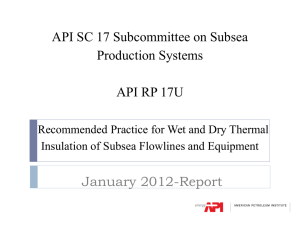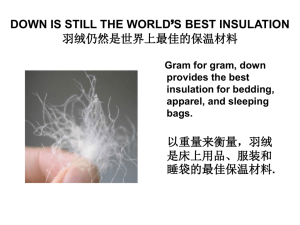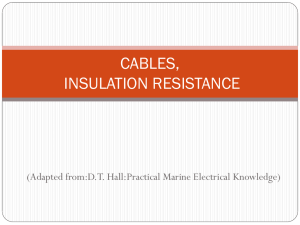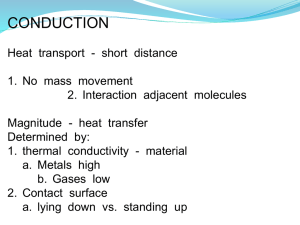Presentation
advertisement
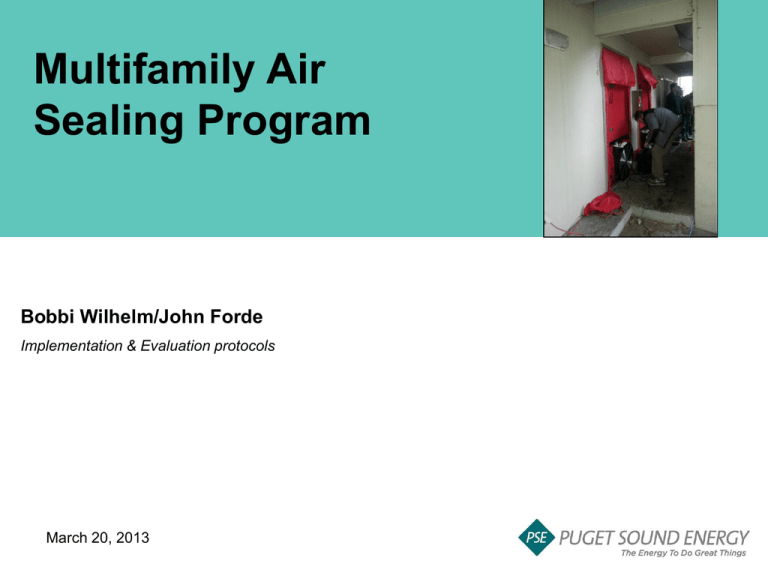
Multifamily Air Sealing Program Bobbi Wilhelm/John Forde Implementation & Evaluation protocols March 20, 2013 Team Introductions Puget Sound Energy: Bobbi Wilhelm: Evaluation John Forde: Market Manager Clint Stewart: Program Manager Arrow Insulation: Ben Burton: Sr. Program Manager Dave Burton: Program Manager Jay Dupree: Field Rep DNV KEMA: Jarred Metoyer & Team 2 Agenda Overview of the Air Sealing Program Buildings Served Air Sealing Video Program Implementation Protocols Video of Air Sealing Project Program Evaluation Protocols/Strategy 3 Why Multifamily Air Sealing I-937 PSE continues to seek new energy savings opportunities in all sectors, including multifamily Based on the number of electrically heated multifamily buildings/units in the PSE service area, there is significant energy savings opportunity. The estimated potential is 200,000 units During the 2012-13 RFP process, Arrow Insulation Inc. submitted a Multifamily Air Sealing Proposal 4 Program Overview Measures Include: Attic air sealing and insulation Dense pack walls/rim joists Floor air sealing and insulation Door gaskets and sweeps Ventilation fan timers Air sealing only measures if already insulated or combined air sealing and insulation On site audit to gather building information Utilizes whole building blower door testing (pre-post) Program Implementation team conducts post installation TREAT modeling. 5 Program Overview Continued Program started January, 2012 and will be completed by December 2013 Building types range from 6 units single story to 20 units with 3 stories and located in most of the service area counties Recruitment through past weatherization participants, program marketing efforts, etc. Owners must commit to no additional energy efficient upgrades for 1 year (including heating season) 6 Units Served to Date Previously Insulated Buildings 18 Buildings 133 Units 71,328 sq ft attic & floor 63,772 sq ft walls Non-previously Insulated: 15 Buildings 142 Units 91,357 sq ft Attic & Floor 58,027 sq ft Walls 7 (no additional insulation): Protocols Comprehensive TREAT audit performed Measures include: Attic air sealing and insulation Dense pack walls/rim joists Floor air sealing and insulation Door gaskets and sweeps Ventilation fan timers Inform property owner/set dates for install Whole building depressurization performed before and after each installed measures 8 Current Infiltration Reduction Measure 9 Infiltration reduction kWh Savings sq. ft. Air Tightening - Ceiling, Floor, Wall insulation to R13 42.62% 1.63 Air Tightening - Ceiling, Wall Insulation to R13 (slab on grade bldgs) 47.88% 2.21 Air Tightening - Ceiling and Floor 27.15% 0.68 Current Infiltration Reduction Measure kWh per sq. ft. Wall Insulation to R13 and Air Tightening 19.85% 3.43 Ceiling Insulation to R38 and Floor to R30 and Air Tightening 32.81% 2.42 44.82% 2.49 Ceiling Insulation to R38, Floor Insulation to R30, Wall Insulation to R13 and Air Tightening 10 Actual reduction Photos 11 Video View Youtube Video 12 Program Implementation & Evaluation The MF Air Sealing Team invited me (evaluation) in the room early The team taught me what air sealing was (thanks!) The team asked for input on what needs to be done so that we can evaluate the program I suggested: Testing out after every measure and randomizing measure installation Help assist with program optimization in event of lower avoided costs Get a consultant on board who deals with complicated engineering & MF evaluations to take a look 13 As of April 2012 Team began testing in and out between measures and randomizing measure installation patterns We sent out an RFP and hired KEMA to assist with a ‘process’ type evaluation Provide us with an overview of evaluation methods given our implementation strategy Give us a ‘best in class’ recommendation for evaluation of the program Provide us with a gap analysis on data needs 14 Evaluation Methods Billing analysis Relatively complex algorithm that is accurate for program and site level, difficult to identify control difficult for regression to address non‐linear effects of occupancy and measures Prototype Simulation with Billing History Affordable accurate for population not accurate at the site level difficulty with understanding the ‘prototype’ Individual building models –use bill history for calibration Higher cost Most Accurate results 15 Current Program Status Test in and out of every building Test out between every measure 16 Multiple blower doors – Whole building approach Provides an understanding of how measures stack up Collecting insulation values pre & post Collecting up to 10 years of billing history data for every building Average Heating Set point (thermostat) is gathered Building, window, etc. square footage Currently collecting lighting wattages Collecting major appliances – letting treat default on annual kWh Next Steps True up modeling with billing history Implement process improvements Air seal final buildngs Complete Evaluation Present findings to RTF 17 Thanks! Questions/Comments? 18


